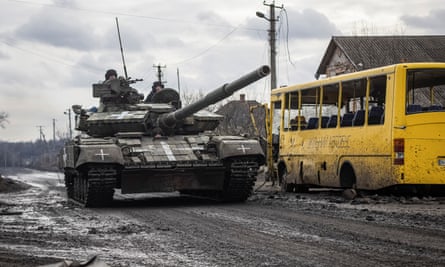Joe Biden and his German counterpart Olaf Scholz have agreed to send infantry fighting vehicles to help Ukraine fight Russia, a day after France said it would supply its own armoured vehicles to Kyiv in an attempt to create a breakthrough in the 10-month war.
The joint announcement followed a phone call between Biden and Scholz and amounts to a step change in western military support for Ukraine, which has asked for up to 700 armoured vehicles to help force the Russians out.
“The United States intends to supply Ukraine with Bradley infantry fighting vehicles, and Germany intends to provide Ukraine with Marder infantry fighting vehicles,” the White House said in a statement on Thursday.
Ukraine has repeatedly said it needs 600 to 700 infantry fighting vehicles plus 300 tanks from from the west in order to give its military a chance of breaking through the increasingly fortified Russian positions along the frontline.
Until now, however, the US and Germany have been wary of supplying Ukraine with Nato-standard armour, because they feared it would be interpreted by Russia as escalatory. But the decision to supply western armoured vehicles is significant, even if both countries stopped short of sending tanks.
Germany will also supply Ukraine with a Patriot air defence system, in addition to one promised by the US last month, the White House added. Both countries will train the Ukrainian military on the Marders and Bradleys, although it it was not immediately clear how many of each would be supplied.
Scholz’s deputy spoke up in support. “This is a good decision,” said Robert Habeck, the German vice-chancellor and economy minister, whose department has to green-light weapons exports.
“Since the start of the war we have continuously expanded our support in coordination with our partners. It is only logical that we also take this step.
“Ukraine has the right to defend itself against the Russian attack, and we have the duty to help her.”

France said on Wednesday it was upping its military aid to Kyiv by supplying an unspecified number of AMX-10 RC light armoured vehicles capable, experts said, of scouting roles and supporting main battle tanks. Hours later Biden hinted the US was considering following with the Bradleys.
Earlier on Thursday, senior German ministers indicated their country’s position was also evolving rapidly. Habeck, on a visit to the Norwegian capital, Oslo, said Germany’s position had never been “static” and that it would be influenced by France and the US’s willingness “to deliver lighter tanks”.
The German foreign minister, Annalena Baerbock, made similar comments. “I have pointed out time and time again we work with our partners to see what kind of military support is required by Ukraine,” she said after a meeting with her British counterpart, James Cleverly, in London. Cleverly himself said tanks “might well be” part of the next phase of weapons transfers.
On Wednesday night, Ukraine’s president, Volodymyr Zelenskiy, said Paris’s decision sent “a clear signal to all our other partners: there is no rational reason why Ukraine has not yet been supplied with western-type tanks”.
Ukraine has long had its eye on western tanks and armour to complement its reduced fleet of Soviet-designed T-64 and T-72 tanks and BMP infantry vehicles, after more than 10 months of fighting.
Kyiv has received about 200 post-Soviet tanks from eastern European countries since the start of the war, but the available supply in Europe is now limited.
To replenish its stocks and build up a fresh attacking force, Ukraine has sought to obtain Leopard 2 tanks, or US-made M1A1 Abrams tanks, but its lobbying was unsuccessful last year.
“Tanks are potentially decisive because there is no substitute if you want to attack enemy formations in defensive positions,” said Ben Barry, a former British army tank commander and land warfare analyst at the International Institute for Strategic Studies thinktank.
Russia has largely sought to dig in since abandoning its exposed position in Kherson on the west side of the Dnipro River in November, as it tries to consolidate its occupation of a swathe of territory roughly the size of Portugal in the east and south of Ukraine.
A breakthrough, if it comes at all, is likely to require the combined use of tanks, heavy armour and infantry, replicating a standard offensive tactic that dates back to the second world war. “The effectiveness of infantry is doubled, even with just three or four tanks helping,” Barry added.
France’s six-wheeled AMX-10 RC were first deployed in the 1980s and have been used in multiple operations, from Afghanistan to Mali. They are in the process of being phased out by Paris, however, making them an ideal gift for Ukraine.
An aide to France’s president, Emmanuel Macron, said it was “the first time that western-designed tanks are supplied to the Ukrainian armed forces” but experts said the AMX-10 RC was too lightly armoured to be considered a proper tank.
Additional reporting by Patrick Wintour
